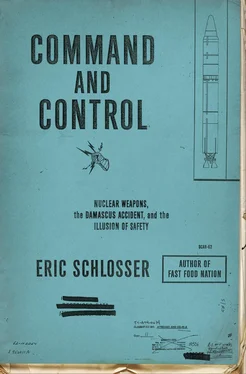Firemen and PTS teams worked in the hot, smoke-filled complex to recover bodies, restore power, and prevent an explosion. At ten o’clock, the temperature in the silo reached 80 degrees, then started to fall. Portable lighting units, generators, and industrial air-conditioners were hooked up, and by early morning an even greater disaster had been averted. The fifty-third body was carried from the silo at daybreak.
An Air Force Accident Investigation Board later concluded that a worker who’d been welding on level 2 inadvertently struck a temporary hydraulics line. When the spray of hydraulic fluid hit the arc of the electric welder, it caught fire. The Air Force attributed the accident to human error. But Gary Lay insisted that nobody had been welding on level 2 and that a mechanical fault had started the fire. He thought that a hydraulics line must have ruptured, spraying flammable oil onto electrical equipment. The missile in the silo wasn’t damaged, and the equipment areas were repaired. About one year after the accident, launch crews were back at the complex near Searcy to pull alerts. It looked just like any other complex, except for a few blackened walls in the silo that someone had forgotten to paint.
• • •
CHILDERS AND HIS CREW PASSED through blast door 8, walked down the short cableway, and entered the launch control center. The room was round and about thirty-five feet in diameter. It was on the second level of a three-story steel structure, suspended on enormous springs, within a buried concrete cylinder. The walls were two feet thick. The ceiling was covered with a maze of ducts and pipes. The color scheme was a mix of pale turquoise, light gray, the dull silver of unpainted steel. The room had the strong, confident vibe of Eisenhower-era science and technology. It was full of intricately wired machinery and electronics — but did not have a computer. To the right stood a series of steel cabinets that displayed the status and housed the controls of the guidance system, the power and electrical systems, the topside alarm. The cabinets were about seven feet tall and covered with all sorts of switches, gauges, dials, and small round lights. In the center of the room was the commander’s console, a small steel desk, turquoise and gray, with rows of square buttons and warning lights. It monitored and controlled the most important functions of the complex. The commander could open the front gate from there, change the warhead’s target, enable or abort a launch. In the middle of the console was the launch switch. It was unmarked, blocked by a security seal, and activated by a key. On top of the console was a digital gauge that showed the pressure in the missile’s fuel and oxidizer tanks. Two small speakers were bolted to the side of the desk. Throughout the day they broadcast test messages from SAC headquarters and, during wartime, would give the order to launch.
To the left of the commander’s console was another small turquoise and gray desk, where the deputy commander sat. It operated the site’s communications systems. Directly above the desk was a large, round clock with numbers from 00 through 23 on the face and a thick black casing. The clock was set to Greenwich mean time, so launches at the Titan II sites in Arkansas, Kansas, and Arizona could be synchronized. The deputy commander’s launch switch was on the upper left side of the desk. It was round, silver, unmarked, and resembled the ignition switch of an old car. The launch codes and keys were kept in a bright red safe with two brass combination locks, one belonging to the commander, the other to the deputy. It was nicknamed the “go-to-war safe.”
If a launch order came over the speakers, the officers were supposed to unlock their locks, open the safe, grab their codes and keys, then return to their consoles. The keys looked unexceptional, like the kind used to unlock millions of American front doors. The codes were hidden inside flat plastic disks called “cookies.” The disks were broken open by hand, like fortune cookies, and the codes were read aloud. And if the codes authenticated the emergency war order from SAC headquarters, the launch checklist went something like this:
SURFACE WARNING CONTROL… Lighted red.
Remove security seals and insert keys into switches.
Launch keys… Inserted.
Circuit breaker 103 on… Set.
BVLC — OPERATE Code Word… Entered.
Simultaneously (within 2 seconds) turn keys for 5 seconds or until sequence starts.
LAUNCH ENABLE… Lighted.
BATTERIES ACTIVATED… Lighted.
APS POWER… Lighted.
SILO SOFT… Lighted.
GUIDANCE GO… Lighted.
FIRE ENGINE… Lighted.
LIFTOFF… Lighted.
Assuming that everything worked as planned, the Titan II would be gone within seconds. Its warhead would strike the target in about half an hour. Once the missile left the silo, the crew’s job was done. They couldn’t destroy a missile midflight or launch another. The complex was designed to be used once.
The Titan II would not launch, however, unless the two keys were turned at the same time; the launch switches were too far apart for one person to activate them both. SAC’s “two-man policy” had been adopted to prevent a deranged or fanatic crew member from starting a nuclear war. The butterfly valve lock on the stage 1 rocket engine offered some additional control over who could launch the missile. Oxidizer wouldn’t flow into that engine until the correct butterfly valve lock code (BVLC) was used during the launch checklist — and without the oxidizer, the missile would stay in the silo. This code wasn’t kept in the safe or anywhere else on the complex. It was transmitted with the emergency war order from SAC. And the valve lock contained a small explosive device. Any attempt to tamper with the lock set off the explosive and sealed the oxidizer line shut.
The SAC two-man rule governed not only how the missile was launched but also how the complex was run. At least two authorized personnel always had to be present and within visual range of each other in the control center. You couldn’t allow the other person out of your sight. The same rule applied in the silo, whenever the missile had a warhead. At entrances to the control center and the silo, a warning stenciled in bold red letters said: “NO LONE ZONE, SAC TWO MAN POLICY MANDATORY.”
• • •
THE COMMANDER AND the deputy commander at every Titan II site were issued .38 caliber revolvers, in case an intruder penetrated the underground complex or a crew member disobeyed orders. Transferring the weapons was part of the turnover checklist, when a new crew arrived for duty. In addition to the handguns and their holsters, Mazzaro and Childers received some bad news from the crew preparing to leave 4–7. Pressure in the stage 2 oxidizer tank was low. A PTS team would have to visit the site, and most of the day would have to be devoted to major maintenance. Before the other crew departed, Mazzaro and Childers opened the safe, made sure the cookies and launch keys were inside, shut it, and installed their own locks.
For the next hour or so Mazzaro, Childers, Holder, and Fuller went through the daily shift verification (DSV) checklist in the control center. They checked every piece of equipment on all three levels of the center, every gauge, switch, and warning light. Level 3 was the basement. It housed the DC power supplies and battery backups, switching equipment for the communications systems, the air-conditioning and ventilation systems. Fresh air was pulled into the control center from outdoors, filtered, cooled, and then sent throughout the rest of the complex. The positive air flow helped to protect the crew from toxic vapors that might drift from the silo. The go-to-war safe, the tall steel cabinets, and the launch consoles were on level 2. The top floor, level 1, had a kitchen, a small round table, four chairs, a toilet, and four beds. The complex had enough food to last for a month, but its emergency diesel generator had enough fuel for only two weeks. During wartime, the crew might find itself eating canned and dehydrated military rations in the dark.
Читать дальше












